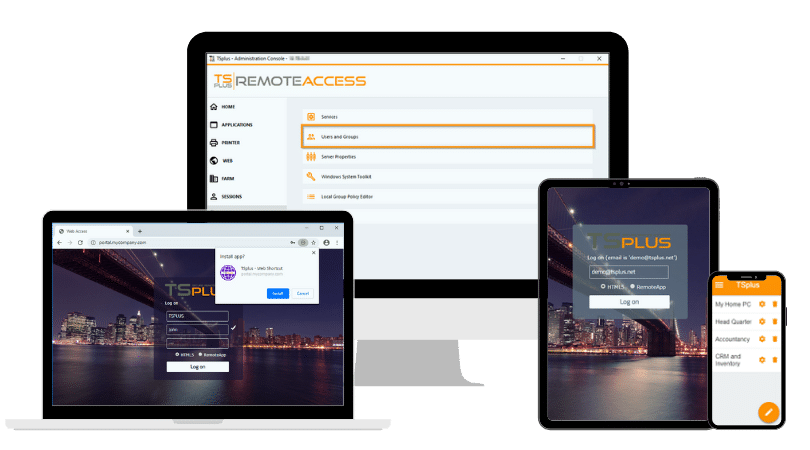)
)
Introduction
Remote Desktop is indispensable for admin work and end-user productivity, but exposing TCP/3389 to the internet invites brute-force, credential reuse, and exploit scanning. A “VPN for Remote Desktop” puts RDP back behind a private boundary: users authenticate to a tunnel first, then launch mstsc to internal hosts. This guide explains the architecture, protocols, security baselines, and an alternative: TSplus browser-based access that avoids VPN exposure.

TSplus Remote Access Free Trial
Ultimate Citrix/RDS alternative for desktop/app access. Secure, cost-effective, on-premises/cloud
What Is a VPN for Remote Desktop?
A VPN for Remote Desktop is a pattern where a user establishes an encrypted tunnel to the corporate network and subsequently launches the Remote Desktop client to a host that is reachable only on internal subnets. The goal is not to replace RDP but to encapsulate it, so the RDP service remains invisible to the public internet and only reachable by authenticated users.
This distinction matters operationally. Treat VPN as network-level admission (you obtain routes and an internal IP) and RDP as session-level access (you land on a specific Windows machine with policy and auditing). Keeping those layers separate clarifies where to apply controls: identity and segmentation at the VPN boundary, and session hygiene and user rights at the RDP layer.
How Does RDP Over VPN Work?
- The Access Model: Network Admission, Then Desktop Access
- Control Points: Identity, Routing, and Policy
The Access Model: Network Admission, Then Desktop Access
“VPN for Remote Desktop" means users first earn network admission into a private segment and only then open a desktop session inside it. The VPN grants a scoped internal identity (IP/routing) so the user can reach specific subnets where RDP hosts live, without publishing TCP/3389 to the internet. RDP isn’t replaced by the VPN; it’s simply contained by it.
In practice, this separate concerns cleanly. The VPN enforces who may enter and what addresses are reachable; RDP governs who may log on to a given Windows host and what they can redirect (clipboard, drives, printers). Keeping those layers distinct clarifies design: authenticate at the perimeter, then authorize session access on the target machines.
Control Points: Identity, Routing, and Policy
A sound setup defines three control points. Identity: MFA-backed authentication maps users to groups. Routing: narrow routes (or a VPN pool) limit what subnets can be reached. Policy: firewall/ACL rules only permit 3389 from the VPN segment, while Windows policies restrict RDP logon rights and device redirection. Together, these prevent broad LAN exposure.
DNS and naming complete the picture. Users resolve internal hostnames via split-horizon DNS, connecting to servers by stable names instead of brittle IPs. Certificates, logging, and timeouts then add operational safety: you can answer who connected, to which host, for how long—proving that RDP stayed private and policy-bound inside the VPN boundary.
What Security Baselines Should Be Applied?
- MFA, Least Privilege, and Logging
- Hardening RDP, Split Tunnelling, and RD Gateway
MFA, Least Privilege, and Logging
Start by enforcing multi-factor authentication at the first entry point. If a password alone opens the tunnel, attackers will target it. Tie VPN access to AD or IdP groups and map those groups to narrow firewall policies so that only the subnets containing RDP hosts are reachable, and only for users who need them.
Centralize observability. Correlate VPN session logs, RDP logon events, and gateway telemetry so you can answer who connected, when, from where, and to which host. This supports audit readiness, incident triage, and proactive hygiene—revealing dormant accounts, anomalous geographies, or unusual logon times that warrant investigation.
Hardening RDP, Split Tunnelling, and RD Gateway
Keep Network Level Authentication enabled, patch frequently, and scope “Allow log on through Remote Desktop Services” to explicit groups. Disable unneeded device redirections—drives, clipboard, printers, or COM/USB—by default, then add exceptions only where justified. These controls reduce data egress paths and shrink attack surface within the session.
Decide on split tunnelling intentionally. For admin workstations, prefer forcing full tunnel so security controls and monitoring remain in path. For general users, split tunnelling can help performance but document the risk and verify DNS behaviour. Where appropriate, layer a Remote Desktop Gateway to terminate RDP over HTTPS and add another MFA and policy point without exposing raw 3389.
How to Implement VPN for Remote Desktop ?
- Design Principles
- Operate and Observe
Design Principles
Never publish TCP/3389 to the internet. Place RDP targets on subnets reachable only from a VPN address pool or a hardened gateway and treat that path as the single source of truth for access. Map personas to access modes: admins may retain VPN, while contractors and BYOD users benefit from brokered or browser-based entry points.
Bake least privilege into group design and firewall rules . Use clearly named AD groups for RDP logon rights, and pair them with network ACLs restricting who can talk to which hosts. Align DNS, certificates, and hostname strategy early to avoid brittle workarounds that become long-term liabilities.
Operate and Observe
Instrument both layers. Track VPN concurrency, failure rates, and geographic patterns; on RDP hosts, measure logon times, session latency, and redirection errors. Feed logs to a SIEM with alerts on brute-force patterns, odd IP reputation, or sudden spikes in failed NLA attempts to accelerate response.
Standardize client expectations. Maintain a small matrix of supported OS/browser/RDP client versions and publish quick-fix runbooks for DPI scaling, multi-monitor ordering, and printer redirection. Review split-tunnel posture, exception lists, and idle timeout policies quarterly to keep risk and user experience in balance.
What Are Common VPN Options for RDP?
- Cisco Secure Client
- OpenVPN Access Server
- SonicWall NetExtender
Cisco Secure Client (AnyConnect) with ASA/FTD
Cisco’s AnyConnect (now Cisco Secure Client) terminates on ASA or Firepower (FTD) gateways to provide SSL/IPsec VPN with tight AD/IdP integration. You can allocate a dedicated VPN IP pool, require MFA, and restrict routes so only the RDP subnet is reachable—keeping TCP/3389 private while maintaining detailed logs and posture checks.
It’s a strong “VPN for RDP” alternative because it delivers mature HA, split/full-tunnel control, and granular ACLs under one console. Teams standardizing on Cisco networking gain consistent operations and telemetry, while users get reliable clients across Windows, macOS, and mobile platforms.
OpenVPN Access Server
OpenVPN Access Server is a widely adopted software VPN that’s easy to deploy on-prem or in cloud. It supports per-group routing, MFA, and certificate auth, letting you expose only the internal subnets that host RDP while leaving 3389 unroutable from the internet. Central admin and robust client availability simplify cross-platform rollouts.
As a “VPN for RDP” alternative, it shines in SMB/MSP contexts: fast standing-up of gateways, scripted user onboarding, and straightforward logging for “who connected to which host and when.” You trade some vendor-integrated hardware features for flexibility and cost control, but you preserve the essential goal—RDP inside a private tunnel.
SonicWall NetExtender / Mobile Connect with SonicWall Firewalls
SonicWall’s NetExtender (Windows/macOS) and Mobile Connect (mobile) pair with SonicWall NGFWs to provide SSL VPN over TCP/443, directory group mapping, and per-user route assignment. You can confine reachability to RDP VLANs, enforce MFA, and monitor sessions from the same appliance that enforces edge security.
This is a well-known “VPN for RDP” alternative because it couples least-privilege routing with practical management in mixed SMB/branch environments. Administrators keep 3389 off the public edge, grant only the routes required for RDP hosts, and leverage SonicWall’s HA and reporting to satisfy audit and ops requirements.
How TSplus Remote Access Is a Secure and Simple Alternative?
TSplus Remote Access delivers the “VPN for RDP” outcome without issuing broad network tunnels. Instead of granting users routes to entire subnets, you publish exactly what they need—specific Windows applications or full desktops—through a secure, branded HTML5 web portal. Raw RDP (TCP/3389) remains private behind the TSplus Gateway, users authenticate and then land directly on authorized resources from any modern browser on Windows, macOS, Linux, or thin clients. This model preserves least-privilege by exposing only application or desktop endpoints, not the LAN.
Operationally, TSplus simplifies rollout and support relative to traditional VPNs. There’s no per-user VPN client distribution, fewer routing and DNS edge cases, and a consistent user experience that reduces helpdesk tickets. Administrators manage entitlements centrally, scale gateways horizontally, and maintain clear audit trails of who accessed which desktop or app and when. The result is faster onboarding, a smaller attack surface, and predictable day-to-day operations for mixed internal, contractor, and BYOD populations.
Conclusion
Putting a VPN in front of RDP restores a private boundary, enforces MFA, and limits exposure without complicating daily work. Design for least privilege, instrument both layers, and keep 3389 off the internet. For mixed or external users, TSplus delivers a secure, browser-based remote access solution with lighter operations and cleaner auditability.














)
)
)